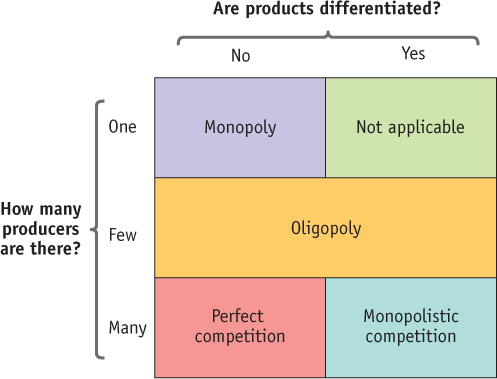13.1 Types of Market Structure
In the real world, there is a mind-
This system of market structures is based on two dimensions:
The number of producers in the market (one, few, or many)
Whether the goods offered are identical or differentiated
Differentiated goods are goods that are different but considered somewhat substitutable by consumers (think Coke versus Pepsi, or an iPhone versus an Android phone).
Figure 13-1 provides a simple visual summary of the types of market structure classified according to the two dimensions. In monopoly, a single producer sells a single, undifferentiated product. In oligopoly, a few producers—

You might wonder what determines the number of firms in a market: whether there is one (monopoly), a few (oligopoly), or many (perfect competition and monopolistic competition). We won’t answer that question here because it will be covered in detail later in this chapter and in Chapters 14 and 15, which analyze oligopoly and monopolistic competition. We will just briefly note that in the long run it depends on whether there are conditions that make it difficult for new firms to enter the market, such as control of necessary resources or inputs, increasing returns to scale in production, technological superiority, a network externality, or government regulations. When these conditions are present, industries tend to be monopolies or oligopolies; when they are not present, industries tend to be perfectly competitive or monopolistically competitive.
You might also wonder why some markets have differentiated products but others have identical ones. The answer is that it depends on the nature of the good and consumers’ preferences. Some goods—
Although this chapter is devoted to monopoly, important aspects of monopoly carry over to oligopoly and monopolistic competition. In the next section, we will define monopoly and review the conditions that make it possible. These same conditions, in less extreme form, also give rise to oligopoly. We then show how a monopolist can increase profit by limiting the quantity supplied to a market—